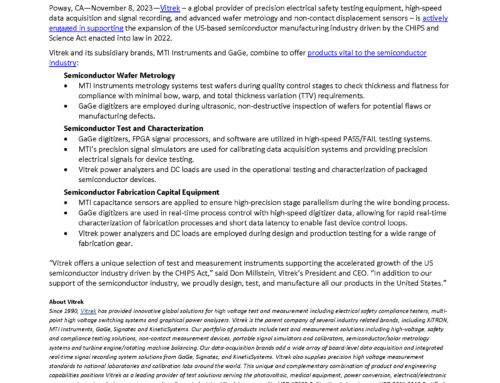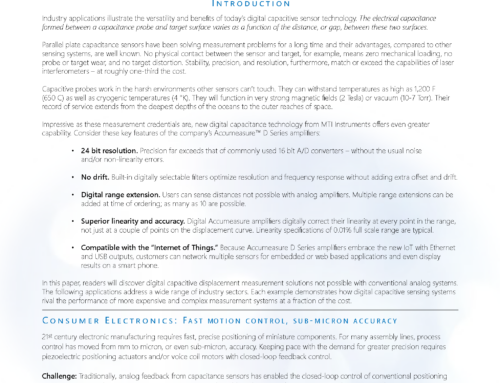High resolution applications do not always require an interferometer. If you want to make accurate measurements in the micron to picometer range, then an MTI Digital Accumeasure D100 HD or D200 system may be what you need. Laser interferometers can sell for more than $15,000 and be difficult to setup. For example, you may have to buy additional optics to guarantee a good return signal since the laser beam must reflect off a mirror surface or precision retro reflector in order for the beam to re-enter the interferometer’s optics at less than a degree of reflection angle.
The downsides of using a costly interferometer don’t end there. Ensuring that the laser beam’s return path is less than a degree may require adding some kind of precision tilt adjustment to the target. Additionally, the optical path may be affected by temperature and humidity, which adds distortion or error to the displacement signal. Interferometers do not require a grounded target and can be tens of millimeters away from the target. By contrast, MTI’s capacitance sensors require only that the target is grounded and that the sensor is reasonably close to the target.
A good example of a precision measurement that can use a capacitance is a piezo electric stage. Ordinarily, the stage target can be grounded and the capacitance probe can be clamped to the stage or mounted so that the capacitance probe can monitor the piezo electric’s metal flexure. The measurement path is therefore short and less subject to temperature drift. MTI’s small, compact, and rugged stainless steel capacitance probe can also be easily customized to mount to the movement stage.
Dynamic Range and Transducer Selection
Interferometers ordinarily require a fringe interpolator circuit that allows much higher resolution than the basic wavelength of the interferometer’s laser light source. This circuitry counts the light fringes and resolves the phase difference between the outgoing light and the returning light. To achieve picometer measurements, the fringe interpolator circuitry must be able to resolve a phase difference of 4000:1 or so. This circuitry can add significant noise and provides a relative reading. This means that if the light beam is blocked, the interferometer loses track of its location (distance from 0 gap ) and the calibration becomes invalid. MTI’s capacitance probe makes an absolute reading; it can’t lose track of the gap distance.
Most interferometers have a huge resolution versus maximum gap distance. This is nice to have but it’s usually unnecessary. MTI’s capacitance probe can have a resolution versus max gap distance of 1,000,000:1 at 50 Hz bandwidth. For example, a 50 µm range probe can resolve 50 pm. That’s a whopping 120 dB dynamic range.
Digital Interface and Transducer Selection
Many traditional transducers have analog outputs and, for the highest accuracy, require converting the analog signal to a digital format such as with a LabVIEW® data acquisition system. MTI’s Accumeasure HD series has 24-bit digital output either via the USB or Ethernet output. Therefore, there isn’t a need to purchase additional data acquisition circuitry.
Read the full interferometer vs Accumeasure HD technology guide
Are you designing a high resolution application? Would you like to learn more about MTI’s Digital Accumeasure D100 HD and D200 systems? Contact us to get started.


